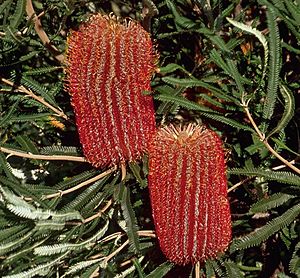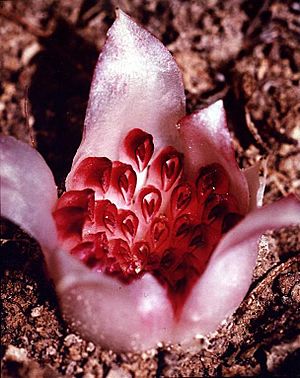List of rare flora of the Esperance Plains region facts for kids
The Esperance Plains region in southern Western Australia is a special place. It is home to many unique plants. Some of these plants are very rare and are called "endangered flora." This means they are at risk of disappearing forever.
Scientists and conservation groups work hard to protect these plants. They keep a list of all the rare plants in the region. This list helps them know which plants need the most help.
Contents
What Are Endangered Plants?
An endangered plant is a type of plant that has very few left in the wild. This means it is in danger of becoming extinct. Extinct means it would no longer exist anywhere on Earth.
In Western Australia, the Department of Environment and Conservation keeps track of these plants. They have a special list called the Declared Rare and Priority Flora List. Plants on this list are protected by law under the Wildlife Conservation Act 1950.
There are 72 types of endangered plants in the Esperance Plains region. One of them, called Acacia prismifolia, is thought to be extinct. This means scientists believe it has already disappeared. The other 71 types are still believed to be alive in the wild.
Meet Some Rare Plants of Esperance Plains
Many different kinds of plants live in the Esperance Plains. Here are some of the rare and special ones:
- Acacia awestoniana
- Acacia rhamphophylla
- Acacia trulliformis
- Adenanthos dobagii (Fitzgerald Woollybush)
- Adenanthos ellipticus (Oval-leaf Adenanthos)
- Adenanthos pungens subsp. pungens
- Adenanthos velutinus (Velvet Woollybush)
- Andersonia axilliflora (Giant Andersonia)
- Anigozanthos bicolor subsp. minor
- Banksia anatona

- Banksia brownii (Feather-leaved Banksia)
- Banksia montana
- Banksia pseudoplumosa
- Banksia verticillata (Albany Banksia)
- Beyeria sp. Bandalup Hill
- Boronia clavata
- Caladenia bryceana subsp. bryceana
- Chamelaucium sp. Hamersley
- Chordifex abortivus
- Conostylis lepidospermoides (Sedge Conostylis)
- Conostylis misera (Grass Conostylis)
- Coopernookia georgei (Mauve Coopernookia)
- Darwinia carnea (Mogumber Bell)
- Darwinia collina (Yellow Mountain Bell)
- Darwinia meeboldii (Cranbrook Bell)
- Darwinia oxylepis (Gilliam's Bell)
- Darwinia sp. Stirling Range
- Darwinia squarrosa (Pink Mountain Bell)
- Darwinia wittwerorum
- Daviesia glossosema
- Daviesia megacalyx
- Daviesia obovata
- Daviesia pseudaphylla
- Deyeuxia drummondii (Drummond Grass)
- Drakaea confluens ms
- Dryandra ionthocarpa subsp. ionthocarpa
- Eremophila ciliata (Archer's Eremophila)
- Eremophila denticulata subsp. denticulata ms
- Eremophila subteretifolia ms
- Eucalyptus burdettiana (Burdett Gum)
- Eucalyptus coronata (Crowned Mallee)
- Eucalyptus insularis (Twin Peak Island Mallee)
- Eucalyptus merrickiae (Goblet Mallee)
- Eucalyptus purpurata
- Eucalyptus steedmanii (Steedman's Gum)
- Gastrolobium luteifolium
- Grevillea infundibularis (Fan-leaf Grevillea)
- Grevillea maxwellii
- Hibbertia priceana
- Kunzea similis
- Lambertia echinata subsp. echinata
- Latrobea obovata ms
- Isopogon uncinatus
- Lambertia fairallii (Fairall's Honeysuckle)
- Lepidium aschersonii (Spiny Peppercress)
- Leucopogon gnaphalioides
- Marianthus mollis (Hairy-fruited Billardiera)
- Myoporum cordifolium
- Orthrosanthus muelleri
- Persoonia micranthera (Small-flowered Snottygobble)

- Rhizanthella gardneri (Underground Orchid)
- Ricinocarpos trichophorus
- Scaevola macrophylla
- Sphenotoma drummondii (Mountain Paper-heath)
- Stachystemon vinosus
- Stylidium galioides (Yellow Mountain Triggerplant)
- Thelymitra psammophila (Sandplain Sun Orchid)
- Verticordia carinata
- Verticordia crebra
- Verticordia helichrysantha (Barrens Featherflower)
- Verticordia pityrhops
- Xyris exilis
The Feather-leaved Banksia
The Banksia brownii, also known as the Feather-leaved Banksia, is a beautiful shrub. It has soft, feathery leaves and unique flowers. This plant is very special to the Esperance Plains. It is one of the many types of Banksia plants found in Australia.
The Amazing Underground Orchid
One of the most unusual plants on the list is the Rhizanthella gardneri, or the Underground Orchid. As its name suggests, this orchid lives its entire life underground! It does not have green leaves like most plants. Instead, it gets its food from a special fungus in the soil. This makes it very hard to find and study.
Why Are These Plants Special?
Every plant plays an important role in its environment. When a plant becomes endangered, it affects the whole ecosystem. Protecting these rare plants helps keep the natural world healthy. It also means future generations can enjoy the unique beauty of Western Australia's flora.
Scientists and conservationists work to understand these plants better. They try to protect their habitats. This includes making sure their natural homes are safe from things like land clearing or changes in climate.

